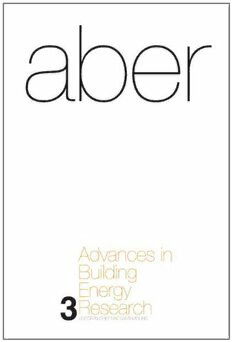
Advances in Building Energy Research: 3 PDF
335 Pages·2007·5.153 MB·English
Most books are stored in the elastic cloud where traffic is expensive. For this reason, we have a limit on daily download.
Preview Advances in Building Energy Research: 3
Description:
'Several high quality scientific journals are published in the area of building energy and indoor/outdoor environment; however, one has been missing. Advances in Building Energy Research fills the gap. I recommend ABER to all technical libraries, research institutes and universities. It should also be used by construction companies and those manufacturing building materials and building products.' Professor Olli Sepp?nen, President of REHVA (Federation of Heating and Air-conditioning Associations) 'Advances in Building Energy Research is a unique index. It will be an inexhaustible resource for energy related sciences and a continuous inspiration for architects around the world.' N. Fintikakis, Architect and Director of UIA-ARES WP (Architecture and Renewable Energy Sources) 'The collection of articles provides an encyclopaedic overview of the state of the art of the subject; and they are written clearly and concisely. This volume is a must for researchers and advanced students.' Professor Edward Ng, Department of Architecture, The Chinese University of Hong Kong 'This is a very valuable first volume of a new series with each section written by leaders in their respective fields. Contributions cover a range of related topics and present evaluations of contemporary issues in building energy research that give the reader an immediate and clear insight.' Dr Adrian Pitts, Senior Lecturer in Energy, Environment and Sustainability, University of Sheffield Advances in Building Energy Research (ABER) offers state-of-the-art information on the environmental science and performance of buildings, linking new technologies and methodologies with the latest research on systems, simulations and standards. As stringently reviewed as a journal but with the breadth of a book, this annual volume brings together invited contributions from the foremost international experts on energy efficiency and environmental quality of buildings. Spanning a broad range of technical subjects, this is a 'must have' reference on global developments in the field, suitable for architects and building engineers, environmental engineers, industry professionals, students, teachers and researchers in building science, technical libraries and laboratories. This first volume covers double skin fa?ades; artificial intelligence in buildings; indoor thermal comfort and the progress of the adaptive approach; heat island research and the effect of urban microclimate; the use of techniques such as high dynamic range imaging and satellite remote sensing; and vital management and monitoring approaches such as post-occupancy evaluation.
See more
The list of books you might like
Most books are stored in the elastic cloud where traffic is expensive. For this reason, we have a limit on daily download.
